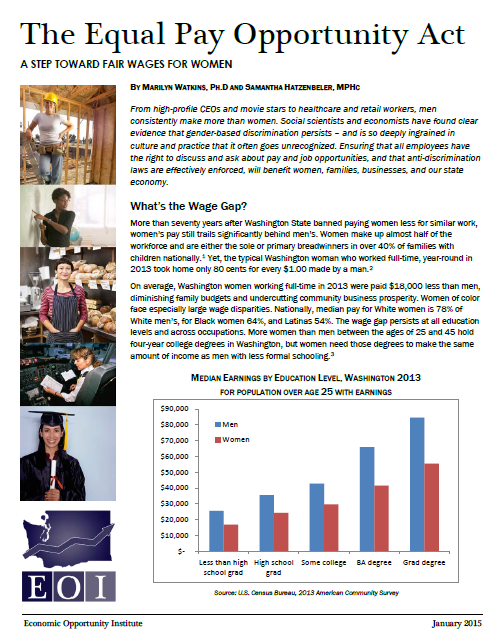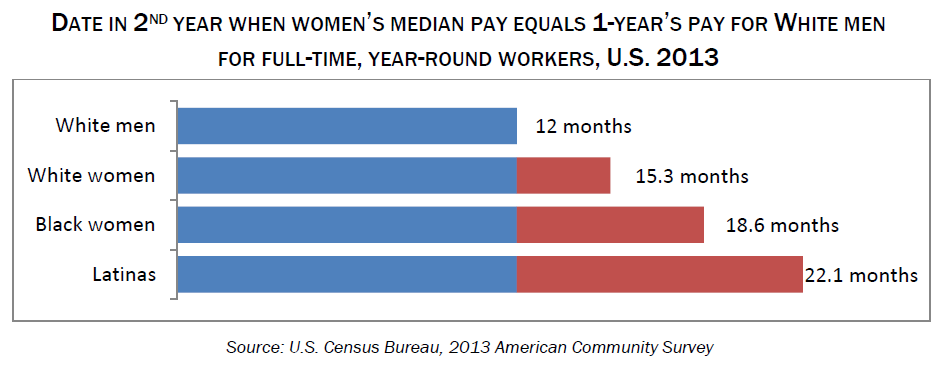By Marilyn Watkins, Ph.D and Sam Hatzenbeler, MPHc
From high-profile CEOs and movie stars to healthcare and retail workers, men consistently make more than women. Social scientists and economists have found clear evidence that gender-based discrimination persists – and is so deeply ingrained in culture and practice that it often goes unrecognized. Ensuring that all employees have the right to discuss and ask about pay and job opportunities, and that anti-discrimination laws are effectively enforced, will benefit women, families, businesses, and our state economy.EOI’s latest policy brief explains what the wage gap is, what causes it, and most importantly, what we can do to fix it.
So what exactly is the wage gap, anyway?
More than seventy years after Washington State banned paying women less for similar work, women’s pay still trails significantly behind men’s. Women make up almost half of the workforce and are either the sole or primary breadwinners in over 40% of families with children nationally. Yet, the typical Washington woman who worked full-time, year-round in 2013 took home only 80 cents for every $1.00 made by a man.
On average, Washington women working full-time in 2013 were paid $18,000 less than men, diminishing family budgets and undercutting community business prosperity. Women of color face especially large wage disparities. Nationally, median pay for White women is 78% of White men’s, for Black women 64%, and Latinas 54%. The wage gap persists at all education levels and across occupations.
Why is there a Wage Gap?
The wage gap persists for a few key reasons:
- Occupational segregation and devaluing “women’s work”: Continued occupational segregation and the lower value society assigns to “women’s work” explain a big part of the wage gap. Segregation persists and men’s jobs pay more within occupational categories.
- Time out for family care: Women are more likely than men to work part-time and to take time out of the workforce for family care responsibilities. In Washington, women make up 47% of the full workforce, but hold only 41% of full-time, year-round jobs.
- Motherhood penalty: On average, mothers tend to make lower wages than women without children, regardless of education and hours worked.
- Discrimination: Economists have found that up to 40% of the wage gap cannot be explained by differences in occupation, industry, union membership, education or experience. At least part of this “unexplained” wage gap is related to discrimination.
Why Existing Laws Aren’t Enough
Washington State passed an Equal Pay Act in 1943 during World War II, when many women were performing traditionally male jobs. That law prohibits paying women less than men in similar work or in jobs formerly held by men. But to pursue a discrimination claim under this law, a woman would have to sue her employer in court and could only recover lost wages, not court costs or attorney fees.
Both Washington State and the federal government have passed additional anti-discrimination laws that protect people in a number of categories, including gender, race, disability or veteran status. Under these laws, however, women must prove intentional discrimination.
Many women never find out they are being paid less due to pay secrecy. While salary information is usually openly available in public sector jobs, one third of private firms admit in national surveys to actively discouraging or prohibiting employees from discussing their pay with other employees.
 Modernizing state law: The Washington Equal Pay Opportunity Act
Modernizing state law: The Washington Equal Pay Opportunity Act
No single policy will close the gender pay gap, but some simple policy changes will make it easier to identify and challenge practices that have discriminatory results:
- Protect the rights of all workers to discuss or ask about compensation, and prohibit retaliation against employees who do so. This will enable workers to find out if others in the company are being paid more for the same work.
- Protect the right of workers to ask why they are being paid less, or why they do not have the same access to job or career opportunities as others.
- Authorize the Department of Labor and Industries (L&I) to investigate charges of gender discrimination so that workers aren’t forced to go to court, and require employers to justify differences with job-related reasons, such as education, skills, or experience.
Pushing to the Next Level
Greater transparency in the workplace will provide everyone with more opportunity to gain equal wages. It will also open new career opportunities for more women and begin to challenge society’s general undervaluing of women’s work. Stronger fair pay legislation, together with more family-friendly workplace policies such as paid sick days, family and medical leave insurance, and reasonable accommodations for pregnant and breastfeeding women, will boost family budgets and women’s lifetime incomes. Local businesses will benefit, and our economy and communities will be stronger, when women have the opportunity to achieve equal pay.
More To Read
October 14, 2025
Opportunity for many is out of reach
New data shows racial earnings gap worsens in Washington
May 19, 2025
A year of reflections, a path forward
Read EOI Executive Director's 2025 Changemaker Dinner speech
March 24, 2025
Remembering former Washington State House Speaker Frank Chopp
Rep. Chopp was Washington state’s longest-serving Speaker of the House


